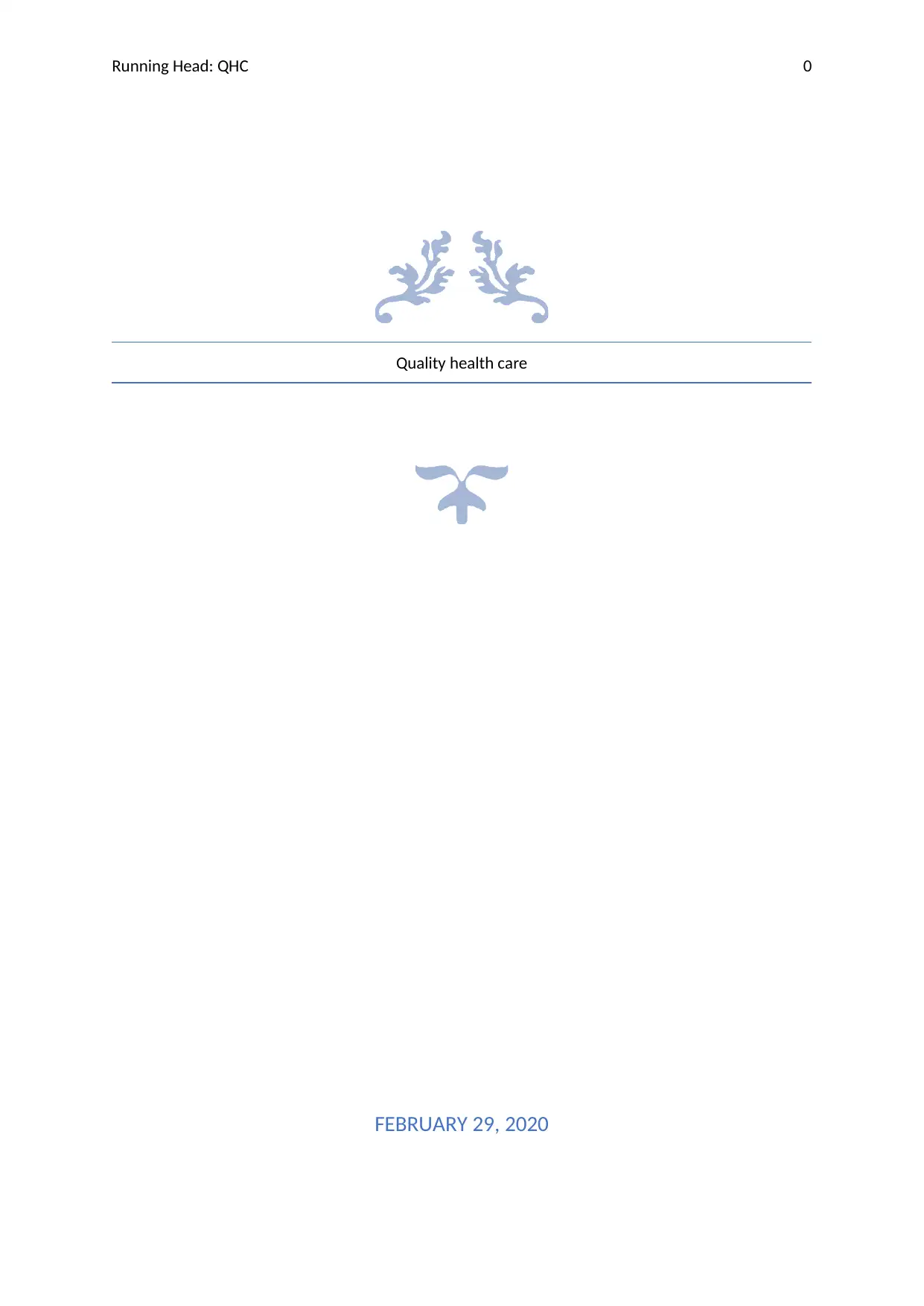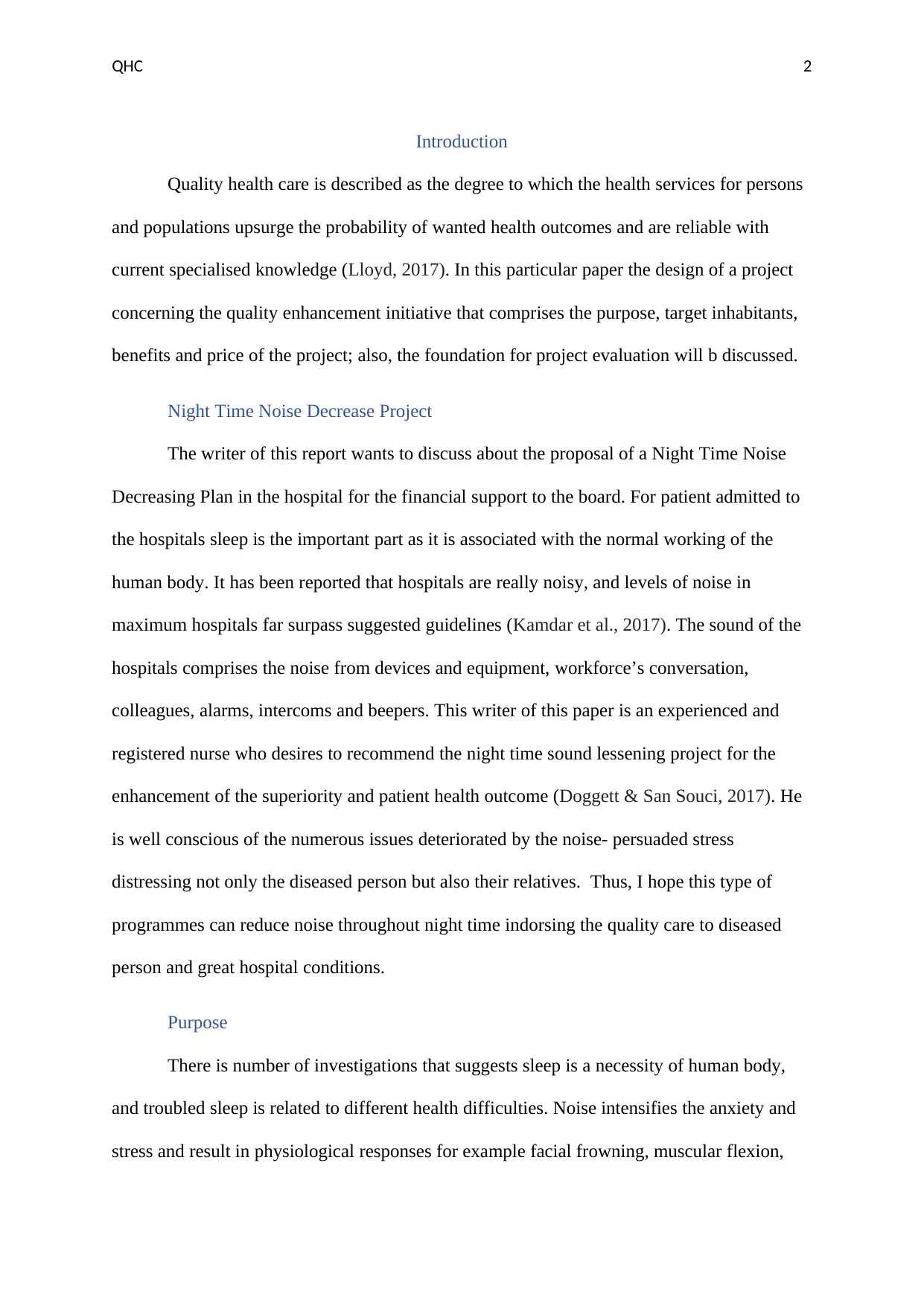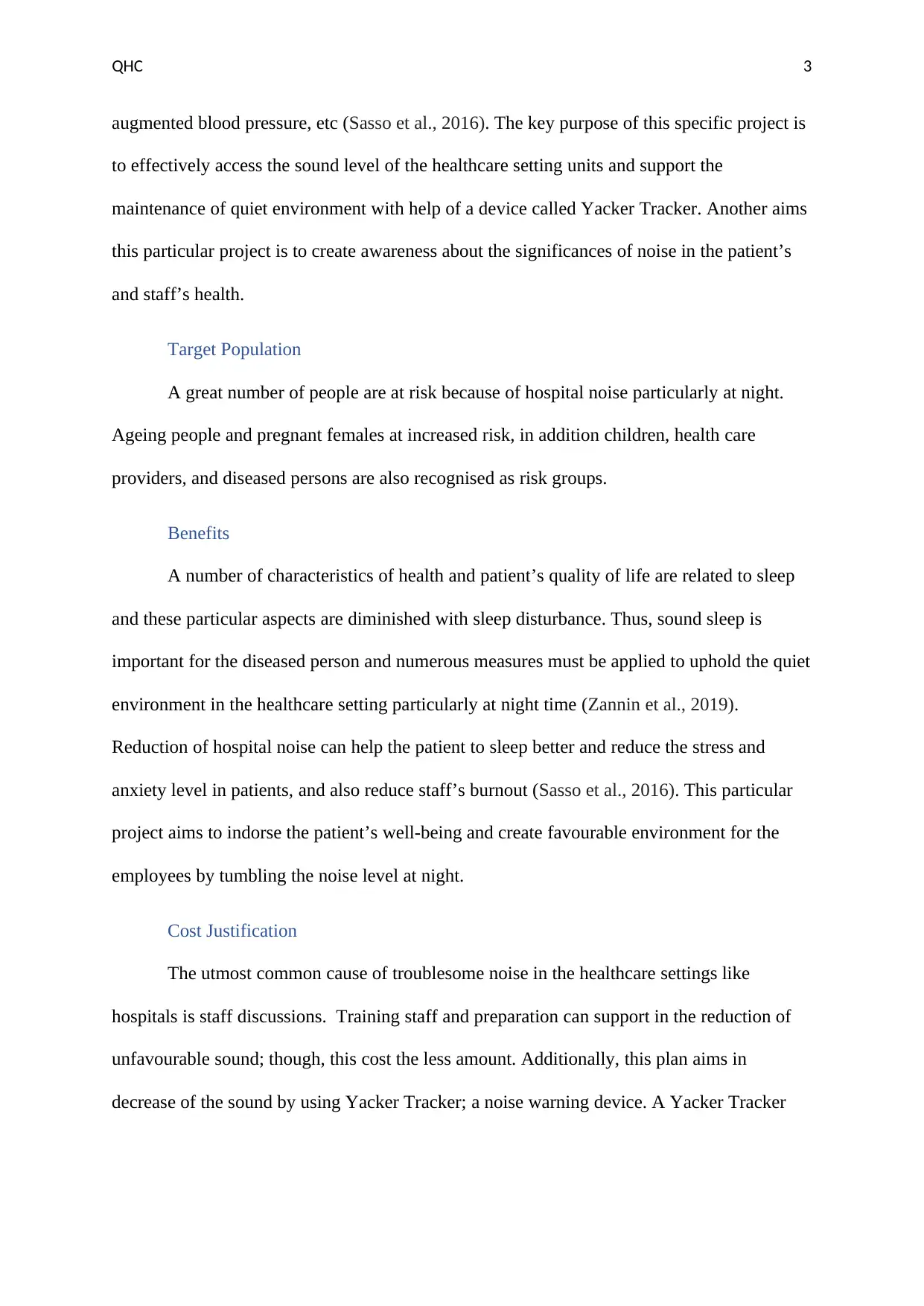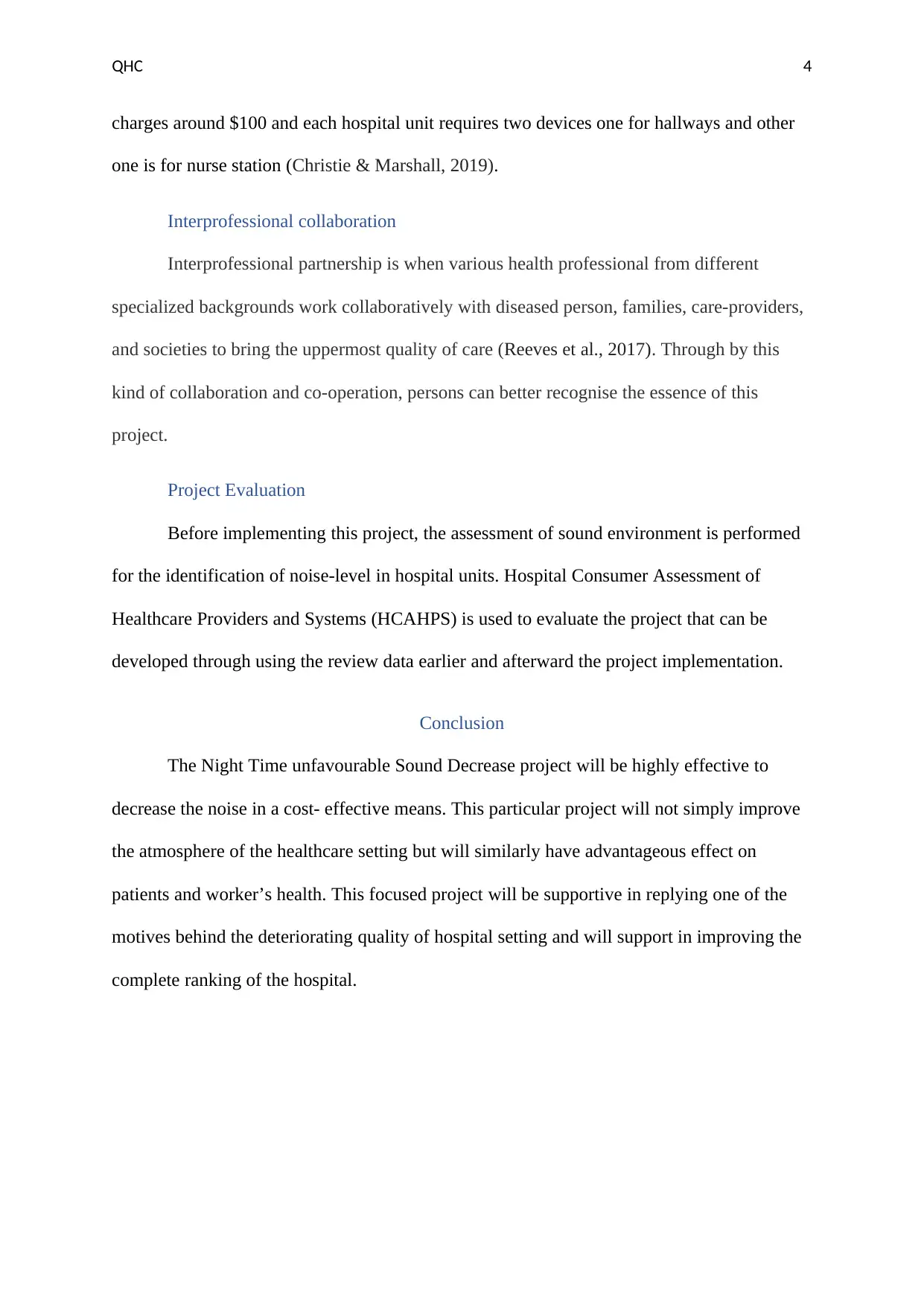QHC 2: Quality Healthcare: Night Time Noise Decrease Project Report
VerifiedAdded on 2022/08/13
|6
|1189
|11
Report
AI Summary
This report presents a project proposal for reducing nighttime noise in hospitals, emphasizing its impact on patient well-being and healthcare quality. The project aims to assess and mitigate noise levels using tools like the Yacker Tracker, targeting vulnerable populations such as the elderly and pregnant women. The report outlines the purpose, benefits, and cost justification of the project, highlighting the importance of interprofessional collaboration. It discusses project evaluation methods, including the use of HCAHPS data, to measure the project's effectiveness in improving the hospital environment and patient outcomes. The conclusion underscores the project's potential to enhance the overall ranking of the hospital by addressing a critical aspect of the healthcare setting.

Running Head: QHC 0
Quality health care
FEBRUARY 29, 2020
Quality health care
FEBRUARY 29, 2020
Paraphrase This Document
Need a fresh take? Get an instant paraphrase of this document with our AI Paraphraser

QHC 1
Contents
Introduction...........................................................................................................................................2
Night Time Noise Decrease Project...................................................................................................2
Purpose.............................................................................................................................................2
Target Population..............................................................................................................................2
Benefits..............................................................................................................................................2
Cost Justification................................................................................................................................2
Interprofessional collaboration.........................................................................................................3
Project Evaluation..............................................................................................................................3
Conclusion.............................................................................................................................................3
Contents
Introduction...........................................................................................................................................2
Night Time Noise Decrease Project...................................................................................................2
Purpose.............................................................................................................................................2
Target Population..............................................................................................................................2
Benefits..............................................................................................................................................2
Cost Justification................................................................................................................................2
Interprofessional collaboration.........................................................................................................3
Project Evaluation..............................................................................................................................3
Conclusion.............................................................................................................................................3

QHC 2
Introduction
Quality health care is described as the degree to which the health services for persons
and populations upsurge the probability of wanted health outcomes and are reliable with
current specialised knowledge (Lloyd, 2017). In this particular paper the design of a project
concerning the quality enhancement initiative that comprises the purpose, target inhabitants,
benefits and price of the project; also, the foundation for project evaluation will b discussed.
Night Time Noise Decrease Project
The writer of this report wants to discuss about the proposal of a Night Time Noise
Decreasing Plan in the hospital for the financial support to the board. For patient admitted to
the hospitals sleep is the important part as it is associated with the normal working of the
human body. It has been reported that hospitals are really noisy, and levels of noise in
maximum hospitals far surpass suggested guidelines (Kamdar et al., 2017). The sound of the
hospitals comprises the noise from devices and equipment, workforce’s conversation,
colleagues, alarms, intercoms and beepers. This writer of this paper is an experienced and
registered nurse who desires to recommend the night time sound lessening project for the
enhancement of the superiority and patient health outcome (Doggett & San Souci, 2017). He
is well conscious of the numerous issues deteriorated by the noise- persuaded stress
distressing not only the diseased person but also their relatives. Thus, I hope this type of
programmes can reduce noise throughout night time indorsing the quality care to diseased
person and great hospital conditions.
Purpose
There is number of investigations that suggests sleep is a necessity of human body,
and troubled sleep is related to different health difficulties. Noise intensifies the anxiety and
stress and result in physiological responses for example facial frowning, muscular flexion,
Introduction
Quality health care is described as the degree to which the health services for persons
and populations upsurge the probability of wanted health outcomes and are reliable with
current specialised knowledge (Lloyd, 2017). In this particular paper the design of a project
concerning the quality enhancement initiative that comprises the purpose, target inhabitants,
benefits and price of the project; also, the foundation for project evaluation will b discussed.
Night Time Noise Decrease Project
The writer of this report wants to discuss about the proposal of a Night Time Noise
Decreasing Plan in the hospital for the financial support to the board. For patient admitted to
the hospitals sleep is the important part as it is associated with the normal working of the
human body. It has been reported that hospitals are really noisy, and levels of noise in
maximum hospitals far surpass suggested guidelines (Kamdar et al., 2017). The sound of the
hospitals comprises the noise from devices and equipment, workforce’s conversation,
colleagues, alarms, intercoms and beepers. This writer of this paper is an experienced and
registered nurse who desires to recommend the night time sound lessening project for the
enhancement of the superiority and patient health outcome (Doggett & San Souci, 2017). He
is well conscious of the numerous issues deteriorated by the noise- persuaded stress
distressing not only the diseased person but also their relatives. Thus, I hope this type of
programmes can reduce noise throughout night time indorsing the quality care to diseased
person and great hospital conditions.
Purpose
There is number of investigations that suggests sleep is a necessity of human body,
and troubled sleep is related to different health difficulties. Noise intensifies the anxiety and
stress and result in physiological responses for example facial frowning, muscular flexion,
⊘ This is a preview!⊘
Do you want full access?
Subscribe today to unlock all pages.

Trusted by 1+ million students worldwide

QHC 3
augmented blood pressure, etc (Sasso et al., 2016). The key purpose of this specific project is
to effectively access the sound level of the healthcare setting units and support the
maintenance of quiet environment with help of a device called Yacker Tracker. Another aims
this particular project is to create awareness about the significances of noise in the patient’s
and staff’s health.
Target Population
A great number of people are at risk because of hospital noise particularly at night.
Ageing people and pregnant females at increased risk, in addition children, health care
providers, and diseased persons are also recognised as risk groups.
Benefits
A number of characteristics of health and patient’s quality of life are related to sleep
and these particular aspects are diminished with sleep disturbance. Thus, sound sleep is
important for the diseased person and numerous measures must be applied to uphold the quiet
environment in the healthcare setting particularly at night time (Zannin et al., 2019).
Reduction of hospital noise can help the patient to sleep better and reduce the stress and
anxiety level in patients, and also reduce staff’s burnout (Sasso et al., 2016). This particular
project aims to indorse the patient’s well-being and create favourable environment for the
employees by tumbling the noise level at night.
Cost Justification
The utmost common cause of troublesome noise in the healthcare settings like
hospitals is staff discussions. Training staff and preparation can support in the reduction of
unfavourable sound; though, this cost the less amount. Additionally, this plan aims in
decrease of the sound by using Yacker Tracker; a noise warning device. A Yacker Tracker
augmented blood pressure, etc (Sasso et al., 2016). The key purpose of this specific project is
to effectively access the sound level of the healthcare setting units and support the
maintenance of quiet environment with help of a device called Yacker Tracker. Another aims
this particular project is to create awareness about the significances of noise in the patient’s
and staff’s health.
Target Population
A great number of people are at risk because of hospital noise particularly at night.
Ageing people and pregnant females at increased risk, in addition children, health care
providers, and diseased persons are also recognised as risk groups.
Benefits
A number of characteristics of health and patient’s quality of life are related to sleep
and these particular aspects are diminished with sleep disturbance. Thus, sound sleep is
important for the diseased person and numerous measures must be applied to uphold the quiet
environment in the healthcare setting particularly at night time (Zannin et al., 2019).
Reduction of hospital noise can help the patient to sleep better and reduce the stress and
anxiety level in patients, and also reduce staff’s burnout (Sasso et al., 2016). This particular
project aims to indorse the patient’s well-being and create favourable environment for the
employees by tumbling the noise level at night.
Cost Justification
The utmost common cause of troublesome noise in the healthcare settings like
hospitals is staff discussions. Training staff and preparation can support in the reduction of
unfavourable sound; though, this cost the less amount. Additionally, this plan aims in
decrease of the sound by using Yacker Tracker; a noise warning device. A Yacker Tracker
Paraphrase This Document
Need a fresh take? Get an instant paraphrase of this document with our AI Paraphraser

QHC 4
charges around $100 and each hospital unit requires two devices one for hallways and other
one is for nurse station (Christie & Marshall, 2019).
Interprofessional collaboration
Interprofessional partnership is when various health professional from different
specialized backgrounds work collaboratively with diseased person, families, care-providers,
and societies to bring the uppermost quality of care (Reeves et al., 2017). Through by this
kind of collaboration and co-operation, persons can better recognise the essence of this
project.
Project Evaluation
Before implementing this project, the assessment of sound environment is performed
for the identification of noise-level in hospital units. Hospital Consumer Assessment of
Healthcare Providers and Systems (HCAHPS) is used to evaluate the project that can be
developed through using the review data earlier and afterward the project implementation.
Conclusion
The Night Time unfavourable Sound Decrease project will be highly effective to
decrease the noise in a cost- effective means. This particular project will not simply improve
the atmosphere of the healthcare setting but will similarly have advantageous effect on
patients and worker’s health. This focused project will be supportive in replying one of the
motives behind the deteriorating quality of hospital setting and will support in improving the
complete ranking of the hospital.
charges around $100 and each hospital unit requires two devices one for hallways and other
one is for nurse station (Christie & Marshall, 2019).
Interprofessional collaboration
Interprofessional partnership is when various health professional from different
specialized backgrounds work collaboratively with diseased person, families, care-providers,
and societies to bring the uppermost quality of care (Reeves et al., 2017). Through by this
kind of collaboration and co-operation, persons can better recognise the essence of this
project.
Project Evaluation
Before implementing this project, the assessment of sound environment is performed
for the identification of noise-level in hospital units. Hospital Consumer Assessment of
Healthcare Providers and Systems (HCAHPS) is used to evaluate the project that can be
developed through using the review data earlier and afterward the project implementation.
Conclusion
The Night Time unfavourable Sound Decrease project will be highly effective to
decrease the noise in a cost- effective means. This particular project will not simply improve
the atmosphere of the healthcare setting but will similarly have advantageous effect on
patients and worker’s health. This focused project will be supportive in replying one of the
motives behind the deteriorating quality of hospital setting and will support in improving the
complete ranking of the hospital.

QHC 5
References
Christie, J., & Marshall, M. (2019). Technology for Organisations Supporting People with
Dementia. Using Technology in Dementia Care: A Guide to Technology Solutions for
Everyday Living, 159.
Doggett, F., & San Souci, S. (2017). Hospital noise mitigation. The Journal of the Acoustical
Society of America, 141(5), 3601-3601.
Kamdar, B. B., Martin, J. L., & Needham, D. M. (2017). Noise and light pollution in the
hospital: a call for action. Journal of hospital medicine, 12(10), 861.
Lloyd, R. (2017). Quality health care: a guide to developing and using indicators. Jones &
Bartlett Learning.
Reeves, S., Pelone, F., Harrison, R., Goldman, J., & Zwarenstein, M. (2017).
Interprofessional collaboration to improve professional practice and healthcare
outcomes. Cochrane Database of Systematic Reviews, (6).
Sasso, L., Bagnasco, A., Aleo, G., Catania, G., Dell'Agnello, D., Currie, K., & Timmons, F.
(2016). Noise on hospital wards–what have we learned?. Journal of clinical
nursing, 25(7), 891-893.
Zannin, P. H. T., Milanês, M. L., & De Oliveira Filho, M. V. M. (2019). Evaluation of Noise
in the Vicinity of a Hospital and a Gated Community. Current Urban Studies, 7(1),
59-75.
References
Christie, J., & Marshall, M. (2019). Technology for Organisations Supporting People with
Dementia. Using Technology in Dementia Care: A Guide to Technology Solutions for
Everyday Living, 159.
Doggett, F., & San Souci, S. (2017). Hospital noise mitigation. The Journal of the Acoustical
Society of America, 141(5), 3601-3601.
Kamdar, B. B., Martin, J. L., & Needham, D. M. (2017). Noise and light pollution in the
hospital: a call for action. Journal of hospital medicine, 12(10), 861.
Lloyd, R. (2017). Quality health care: a guide to developing and using indicators. Jones &
Bartlett Learning.
Reeves, S., Pelone, F., Harrison, R., Goldman, J., & Zwarenstein, M. (2017).
Interprofessional collaboration to improve professional practice and healthcare
outcomes. Cochrane Database of Systematic Reviews, (6).
Sasso, L., Bagnasco, A., Aleo, G., Catania, G., Dell'Agnello, D., Currie, K., & Timmons, F.
(2016). Noise on hospital wards–what have we learned?. Journal of clinical
nursing, 25(7), 891-893.
Zannin, P. H. T., Milanês, M. L., & De Oliveira Filho, M. V. M. (2019). Evaluation of Noise
in the Vicinity of a Hospital and a Gated Community. Current Urban Studies, 7(1),
59-75.
⊘ This is a preview!⊘
Do you want full access?
Subscribe today to unlock all pages.

Trusted by 1+ million students worldwide
1 out of 6
Related Documents
Your All-in-One AI-Powered Toolkit for Academic Success.
+13062052269
info@desklib.com
Available 24*7 on WhatsApp / Email
![[object Object]](/_next/static/media/star-bottom.7253800d.svg)
Unlock your academic potential
© 2024 | Zucol Services PVT LTD | All rights reserved.





